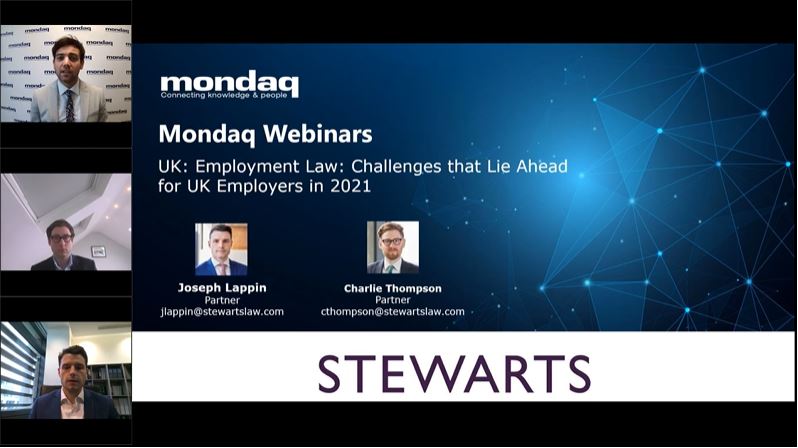Joseph Lappin and Charlie Thompson, Partners in our Employment department recently spoke at a webinar hosted by Mondaq, looking at the challenges that are likely to face employers in 2021.
The webinar can be viewed in full here, and a detailed account of the points covered can be found below.
The state of the Employment Tribunal
We anticipate more claims, disputes lasting longer and less of an incentive for parties to settle.
Since Tribunal fees were abolished in 2017, claim numbers have increased. That trend continued and appeared to accelerate following the lockdown in March 2020.
The Tribunal has a longstanding backlog of claims, which has grown during the pandemic. In August 2020, there were 45,000 outstanding claims, and the backlog increased every week since March. Hearings are being listed further and further in the future, with hearings for claims in some Tribunals not being listed until over a year after they were submitted. Tribunals are now less able to front-load case management directions, which often had the effect of focusing the parties’ minds on settlement.
The Tribunal has reacted by changing its procedural rules, and the biggest change has been the increase of remote hearings. The Tribunal has continued to conduct hearings in person, but also on a cloud video platform, and sometimes a mixture of the two.
We have received positive feedback about remote hearings. One example is that the administrative headache of getting all the employer’s witnesses out of the office to sit in a Tribunal building for days on end is removed.
It is worth noting that they can also fundamentally change the dynamic of a dispute. For example:
- the judge and the Tribunal panel make fewer interruptions during a remote hearing;
- Written submissions appear to be given more weight than before;
- The possibility of settling a dispute on the Tribunal steps has diminished because the parties are no longer in the same building. Therefore, there is less of a chance to initiate those spur-of-the-moment conversations about settlement.
The pandemic
Despite the enormous upheaval caused by the pandemic and changes in attitudes towards work, the law is mostly unchanged. While some emergency measures have been introduced, such as the furlough scheme, the overarching legal framework is the same. Until the government introduces its long-awaited employment bill, the key in 2021 for employers is not so much adapting to new law, but adapting to a new environment and spotting where issues are likely to emerge.
Of the many changes employers will face in 2021, we consider the following three to be among the most significant:
- Redundancies and restructures
- Disputes over pay and bonuses
- The return to work and life beyond lockdown.
Redundancies and restructures
There was a record number of redundancies in 2020. Between August and October 2020 alone, there were nearly 370,000, more than at the height of the 2008 financial crisis. We can expect more:
The anticipated end of the furlough scheme will bring another spike of redundancies. While one of the furlough scheme’s stated intentions was to avoid redundancies, it has perversely expedited redundancies in some cases as it has led many employers to conclude that they can be just as efficient with a reduced headcount.
In addition to the furlough scheme, there have been numerous forms of moratorium to avoid insolvencies and lease forfeiture. These have been so successful that in Q3 of 2020 there was the lowest number of corporate insolvencies since Q4 of 2015. There are likely to be some businesses that will need to make redundancies in 2021 to avoid insolvency.
We can expect employees to be more likely to contest these processes:
- One of the most effective ways to diffuse an employment dispute is for the employee to have the prospect of another job to go to. According to recent figures from ONS, job vacancies across the economy are still far below pre-pandemic levels and 31.5% lower than they were at the end of 2019.
- After a year of remote, reduced and agile working, employees will be more able to propose compelling alternatives to redundancy.
Disputes over pay and bonuses
The economic collapse post-2008 brought a slew of disputes over pay and bonuses. With prolonged uncertainty ahead of us, we can reasonably expect more of this on the way.
There will be divided opinion about the payment of bonuses by a company that has taken government support and made staff redundant. However, some businesses and individuals have performed extremely well in the last year. Even for businesses that have struggled, there will be cases where the business has survived because of the exceptional performance of certain employees. Employees in those organisations will rightly feel aggrieved if their individual performance is not rewarded.
It may be tempting to exercise extreme caution in this area by awarding low bonuses, but this potentially puts the employer at risk on another front. Failing to reward top performers properly leaves an employer open to raids from competitors. For many businesses, this year represents a once-in-a-blue-moon opportunity to recruit top talent from competitors, especially those on historic contracts with shoddy post-termination restrictions. So, we can expect a surge of litigation.
Life beyond lockdown and the return to the workplace
The return to the workplace
There remains a desire among employers and employees to return to the workplace. However, this will be delicate, not just because of the pandemic but also because of the success with which most employees and employers have adapted to working remotely.
It has become clear that people can be productive away from the office. The technology has long existed to make this possible, as has the technology to monitor performance. Further, the loss of the daily commute has (in theory) improved work-life balance. Many employees and employers will not want to go back to how it was pre-pandemic. A YouGov poll shows that 68% of British employees had never worked from home prior to the first lockdown. Now, 57% want to continue working from home in some form after the pandemic ends.
However, for all the virtues of remote and agile working, it does not provide the same opportunities for collaboration as being physically in the same premises. Similarly, it is much more difficult to train, supervise and manage junior staff when they are at home. We also hear a lot of feedback from clients that remote working can have a negative impact on morale and an organisation’s sense of culture.
Three risks arise from an instruction to return to the workplace:
- allegations that by issuing the instruction and presumably threatening the employee with an allegation of misconduct if they do not comply, the employer is acting in breach of the implied contractual term of mutual trust and confidence.
- the assertion of whistleblower protection under the Employment Rights Act. While government lawyers back in the ‘90s may not have anticipated a global pandemic when drafting the legislation, it is easy to imagine that a simple one-line response from an employee to a request to return to work could obtain this protection.
- indirect discrimination claims, in particular in relation to employees with care responsibilities or a disability
Increased remote working
The perceived success of remote working can distract from some of the challenges it presents. An employer’s liability is not waived by the fact that the employees are not in the office. Further, while employees are away from the employer’s watchful eye, it may be more difficult to identify and address any issues.
It will become increasingly difficult for employers to reject flexible working requests, as it is now plain to see that non-typical ways of working can be highly effective.
In that context, we are likely to see in 2021 and beyond an increasingly disparate workforce, with a greater blend of full-time and part-time working and a greater mix of staff in the office and working remotely. There is a significant risk that the people who are not in the office are out of sight and out of mind, while those who come into the office more regularly are seen as ambitious and dedicated. Ensuring that people are treated fairly is a key challenge.
On a day-to-day level, managers are now in a position where they must be much more proactive and upskilled to deal with the new working environment. There is a risk that staff who are not physically present at work are more likely to be “forgotten about”. They may be not included in key meetings or discussions, and they may miss opportunities for advancement. Factions can emerge between those who are always in the office and those who are not, as well as allegations of favouritism.
Underlying issues about conduct, performance or wellbeing may be more likely to fester and go unaddressed for longer. In the case of grievances, pre-pandemic many employees would have been deterred from raising a grievance about a colleague by the prospect of having to go into the office and look that colleague in the eye. In an era of remote working, this deterrent does not exist, and employees are more emboldened to raise complaints.
While physical distancing may appear to make bullying and harassment less likely, issues will continue to arise in different, more insidious manners. Not only will there be fewer witnesses to inappropriate behaviour, but technology allows for bullying to take place more indirectly, for example, abruptly hanging up on people or inconsiderate timing of emails or calls. Managers are more likely to be seen as managing in an overbearing way.
This presents operational challenges, but it also presents genuine risks to employee mental health. Despite the success stories about remote working, for many, it has had a negative impact on work-life balance. The monotony and isolation of working from home and the relentless barrage of zoom meetings, combined with challenges of home-schooling and the closure of childcare, has put many at risk of mental illness.
Not only might grievances be raised and potential claims for discrimination, harassment and constructive dismissal, but also personal injury claims. Employers have a duty to provide a safe place and system of work. If an employee becomes severely unwell because of working conditions at home, the employee may hold the employer responsible.
Brexit: what might it mean for employment law?
After four years of often fractious negotiations, agreement on the UK’s future trading relationship with the EU was formalised in the Trade and Cooperation Agreement, which came into force on 1 January 2021.
In the days following conclusion of the deal, Kwasi Kwarteng, the business secretary, confirmed that the government would review how employment laws could be changed after Brexit. Many saw his comments as a signpost for comprehensive changes to UK employment laws. This delighted neoliberals who saw Brexit as an opportunity for the UK to go alone and become a low tax and low regulation state.
In the end, in another government U-turn, Mr Kwarteng admitted on 27 January (the day after our seminar) that his review into employment laws would be scrapped. This climb down delighted those who feared the government would take a wrecking ball to employment rights. However, in reality, substantial changes to UK employment laws were always unlikely, especially during a global recession.
The Trade and Cooperation Agreement (TCA) between the UK and the EU contains ‘level playing field commitments’ which should ensure that neither the UK nor the EU obtains a competitive advantage in various regulatory areas, including labour laws. The UK and the EU have committed to not reducing their “labour and social standards” in a manner that would “affect trade or investment”. This applies to employment standards, health and safety, working conditions, and so forth.
The TCA also includes safeguards that will kick in should one side fail to comply with their level playing field commitments in a way which has a material impact on trade and investment. So, although there is no absolute prohibition of making wholesale changes to employment laws, if one side suspects that the other has implemented a law which gives it a competitive advantage, it can call for an arbitration panel to resolve the dispute in a binding manner. If there has been significant divergence by one side, the other can apply hefty tariffs.
Therefore, it will be difficult for the UK to water down workers’ rights to give UK businesses a competitive edge without facing the real prospect of retaliatory action by the EU. A bust-up with the EU on workers’ rights is the last thing Boris Johnson needs right now.
This doesn’t mean there will be no changes to employment laws this year. There are likely to be some changes, but they will not be drastic. The government will (probably) want to demonstrate that a consequence of leaving the EU is that it can change laws free from the jurisdiction of the EU and the European Court of Justice.
Parliament could introduce new legislation to:
- Scrap the law, imposed on the UK by a European case, which prevents the new employer harmonising terms and conditions of employment after a TUPE transfer;
- Dilute or even reverse the effect of a series of European cases, which mean that holiday pay should include commission, overtime and certain types of bonuses;
- Introduce a cap on compensation awards in discrimination claims (currently, unlike in unfair dismissal claims, there is no cap).
It is too early to say what changes the government might make in the longer term. That said, rather than make wholesale changes to UK employment laws, there may well be a desire by the government to forge closer links with the EU. If the disruption of Brexit becomes apparent, or if Brexit is a total disaster, the government will probably want to improve the UK’s relationship with the EU. Mirroring EU employment laws is one way to forge closer links.
Black Lives Matter movement
The Black Lives Matter (BLM) movement came to prominence in the UK last year when protests took place across the country in support of those taking place in the US in the aftermath of the tragic death of George Floyd at the hands of the police.
The protests’ principal aim was to highlight the prevalence of racial inequality and race discrimination in the UK. The demonstrations have reminded us of our failings and concerns as a nation: the Windrush scandal, the Home Office hostile environment policy, and the murder of Stephen Lawrence to name but three.
The BLM movement has attracted huge publicity, and the issues of race and inequality are at the forefront of our minds.
In an employment context, comparisons can be made between the MeToo and BLM movements. Soon after the MeToo movement took hold, we saw an increase in the number of instructions we received from clients wishing to pursue sex discrimination complaints. Clients would often refer to MeToo as the catalyst for contacting lawyers. The number of sex discrimination claims being brought in the Employment Tribunal has risen considerably since MeToo.
It is fair, therefore, to say that MeToo resulted in women feeling more confident when calling out sexist behaviour and has led to a greater awareness of the legal protections afforded to women at work.
The Equality Act 2010 prohibits direct and indirect discrimination, harassment and victimisation on the ground of various protected characteristics, including “race”. Race is broadly defined in the Act and includes colour, nationality, and ethnic or national origins.
We might see an increase in race discrimination complaints this year, in particular harassment complaints, as employees feel emboldened and more willing to speak up and call out bad behaviours at work, in large part as a result of the impact of the BLM movement.
We have identified three effective steps employers can implement quickly to tackle racial inequality at work.
- Employers can establish an inclusion committee responsible for driving the organisation’s diversity, equality, and inclusion strategy and implementing initiatives that embed this strategy into its activities and actions.
- Employers should review their approach to recruitment and make sure they are attracting and recruiting talent from a diverse range of candidates with different backgrounds.
- Employers should be prepared to deal with complaints properly. Employers who do not act decisively when faced with complaints of race harassment may suffer damage to their reputation, especially if complaints progress to an employment tribunal. If the employer is a well-known brand, the reputational fall out could be severe. Perhaps more importantly, for employees who raise complaints and then find that their employer does not believe them or does not deal with their complaints properly, the impact on their wellbeing can be tremendous.
The webinar can be viewed in full here.
You can find further information regarding our expertise, experience and team on our Employment page.
If you require assistance from our team, please contact us or alternatively request a call back from one of our lawyers by submitting this form.
Subscribe – In order to receive our news straight to your inbox, subscribe here. Our newsletters are sent no more than once a month.









